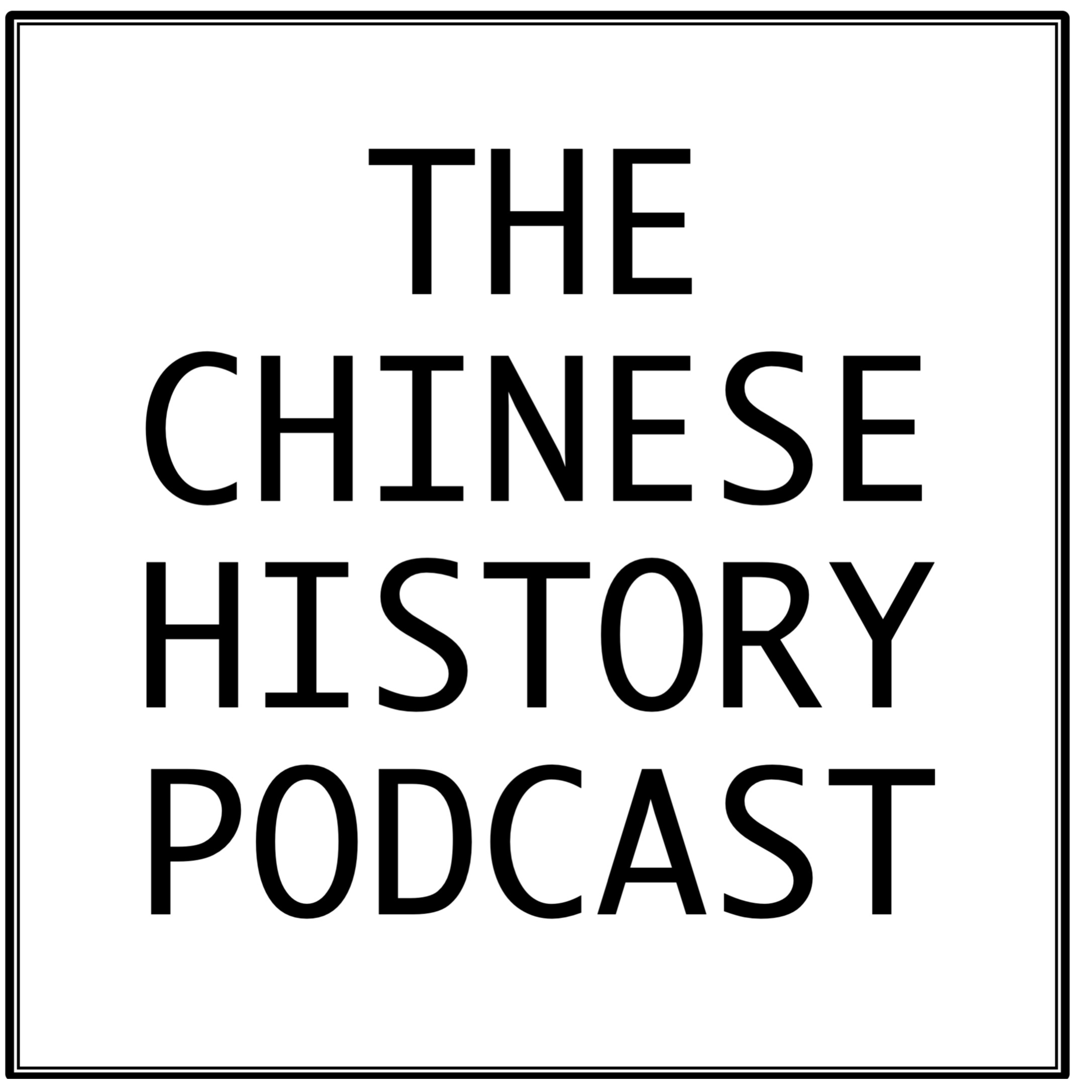Episodes
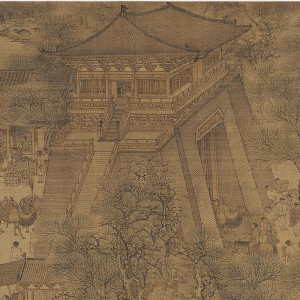
Wednesday Jan 12, 2022
Wednesday Jan 12, 2022
The Northern Song (960-1127) capital city of Kaifeng (also known as Bianjing or Dongjing) was the largest city in the medieval world. Its population surpassed the previous capitals of Chang'an and Luoyang and dwarfed contemporary world cities such as Baghdad and Constantinople. At its peak, Kaifeng boasted a population of well over a million people and was home to hundreds of thousands of soldiers. It was also the central node of vast transportation network consisting of rivers, canals, and roads and as a result became a huge commercial center. It's wealth and prosperity has been immortalized in the famous painting Qingming shanghe tu (清明上河圖), which offers various depictions of daily life in the bustling city. Yet at what cost was this prosperity achieved? How was this vast city supplied? How did Kaifeng's consumption, and by extension the Northern Song's rapid economic and technological development as whole, impact the environment and change ecological features? And in our own age of climate change, what lessons can we draw from the history and experience of Song Kaifeng? To answer these questions, we interviewed Dr. Yuan Chen, an environmental historian of premodern China with a focus on Song Kaifeng, who will talk to us about the fascinating history of Kaifeng during the Northern Song and Kaifeng's broader impacts on China.
Note: We apologize for some minor audio distortions in the interview.
Contributors
Yuan Chen

Yuan Chen is a Postdoctoral Associate at the Franklin Humanities Institute & Global Asia Initiative at Duke University. She received her PhD from Yale University and was also a Visiting Professor at Boston College. Her current research focuses on the environmental history of premodern and early modern East Asia, and she is working on a book manuscript that seeks to explore the environmental changes of Middle Period China from the view of the imperial capital of Kaifeng and Kaifeng’s ecological and economical connections with its diverse supplying regions in China and beyond. Her works have been published in several historical journals, and her teaching interests include Chinese history, Tokugawa Japan, early modern global history, environmental history, and the Silk Road.
Yiming Ha

Yiming Ha is a Ph.D. candidate in the Department of History at the University of California, Los Angeles. His current research is on military mobilization and state-building in China between the thirteenth and seventeenth centuries, focusing on how military institutions changed over time, how the state responded to these changes, the disconnect between the center and localities, and the broader implications that the military had on the state. His project highlights in particular the role of the Mongol Yuan in introducing an alternative form of military mobilization that radically transformed the Chinese state. He is also interested in military history, nomadic history, comparative Eurasian state-building, and the history of maritime interactions in early modern East Asia. He received his BA from UCLA and his MPhil from the Hong Kong University of Science and Technology.
Credits
Episode No. 6
Release date: January 12, 2021
Recording location: Chicago, IL/ Los Angeles, CA
Bibliography courtesy of Dr. Yuan Chen
Images
Map of Kaifeng, c. 1100 (Image Source: West, Spectacle, Ritual, and Social Relations.")
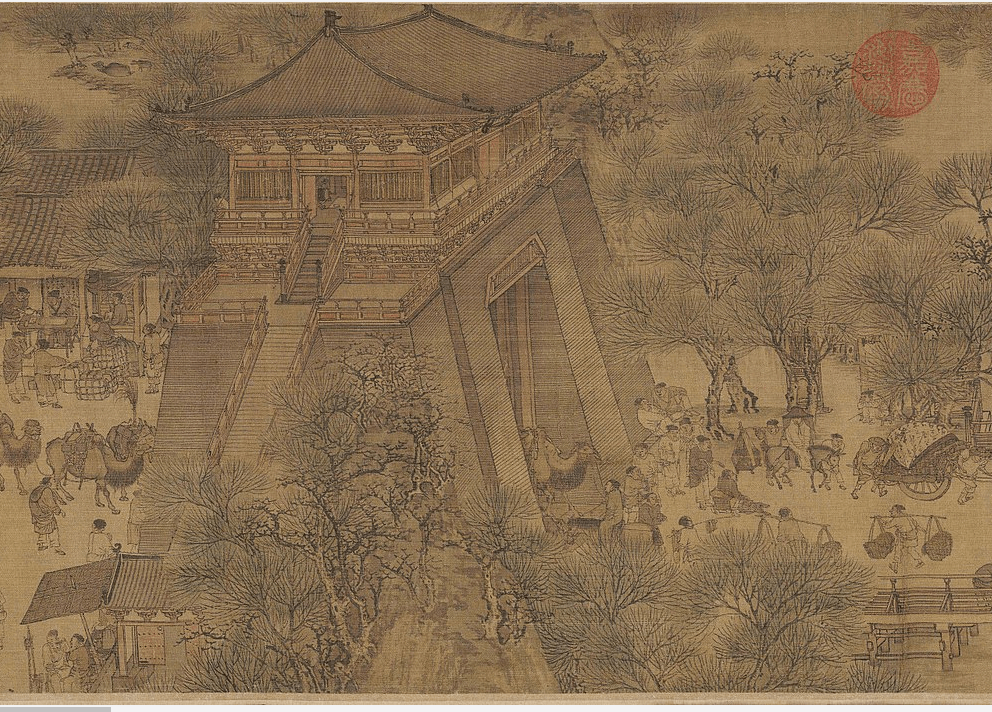
Cover Image: City Gate of Kaifeng, as depicted in the Qingming shanghe tu (view full painting here).
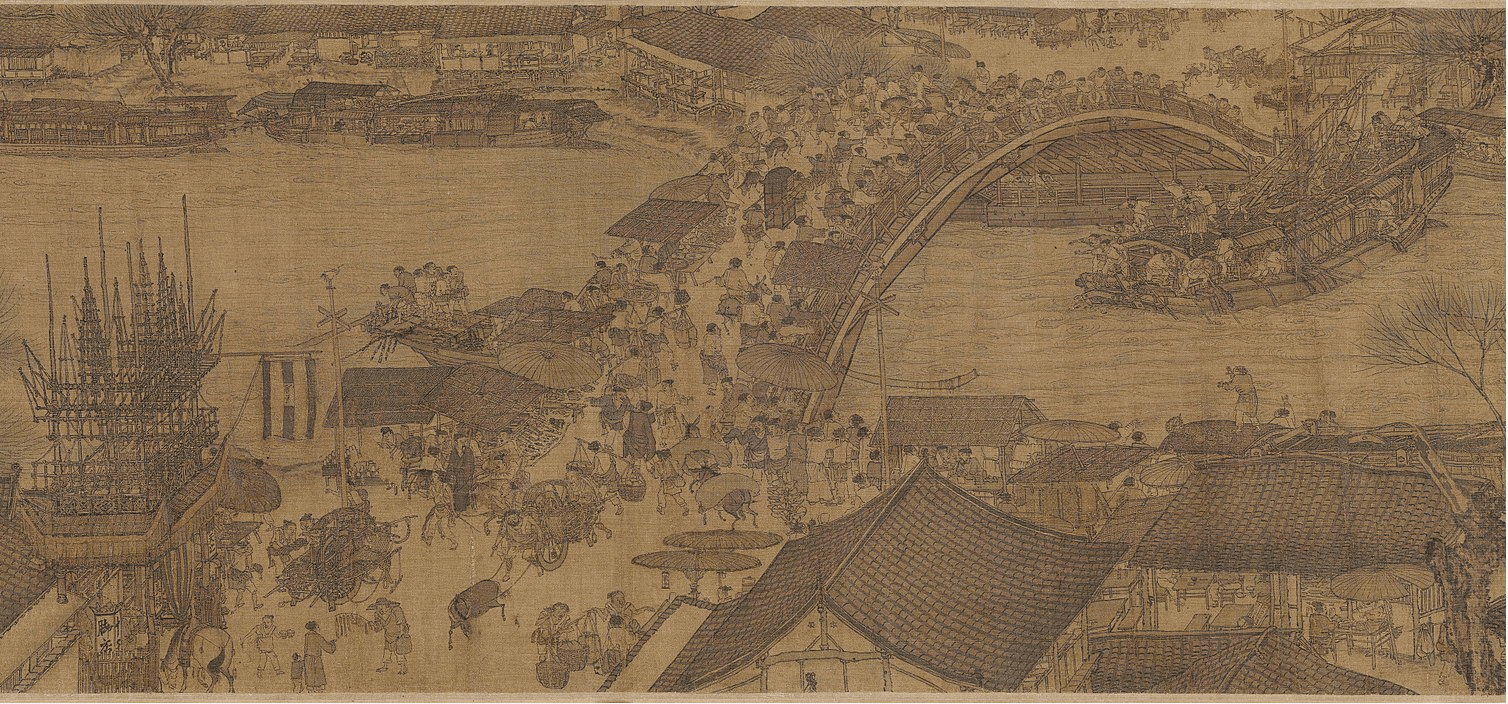
The famous bridge scene in Qingming shanghe tu (view full painting here).
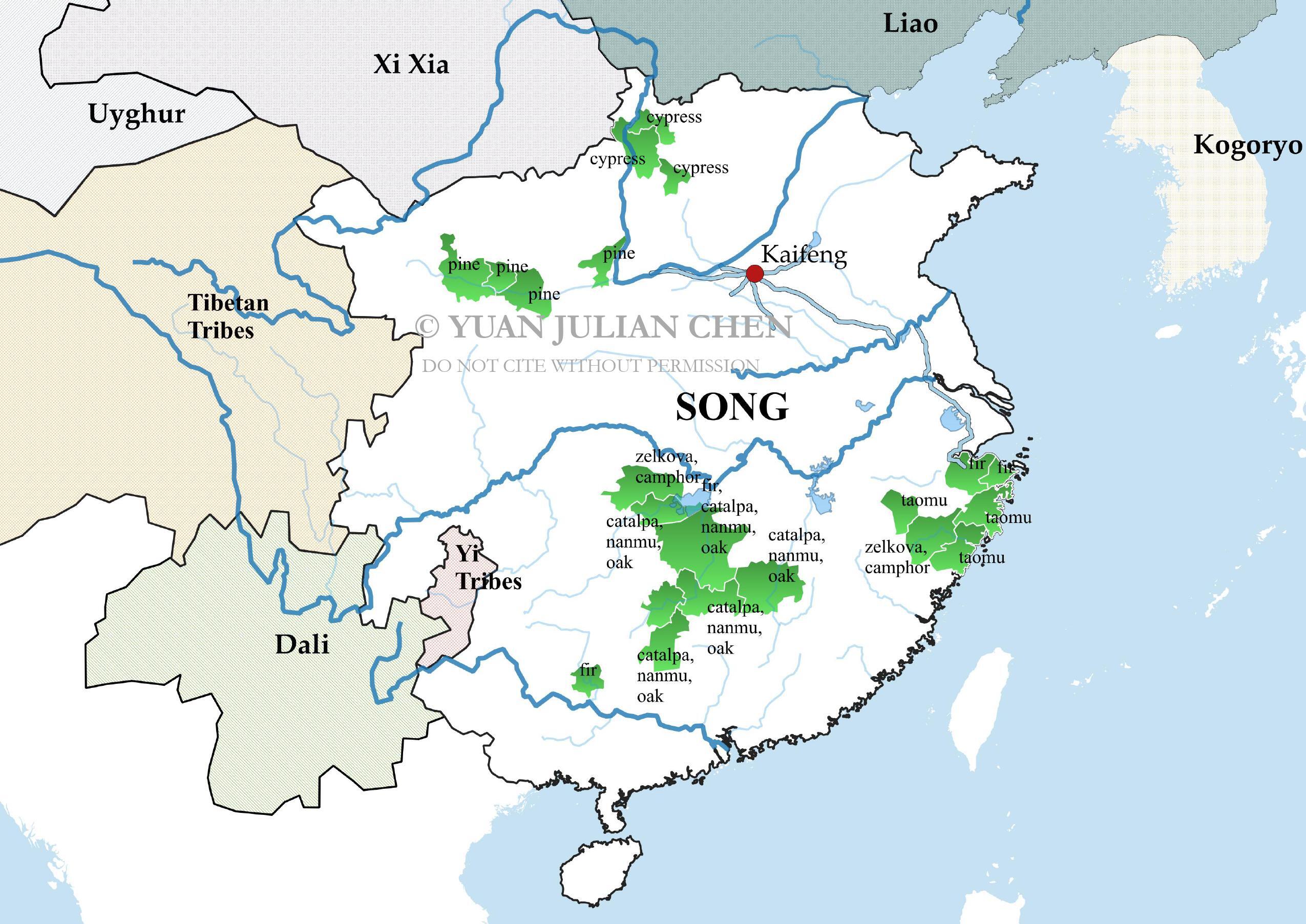
Supply of timber for the construction of the Yuqing Temple (Image Source: Chen, "China’s Song-dynasty Capital of Kaifeng and its Hinterlands."). Reproduced here with permission from author. Please do not cite without permission.
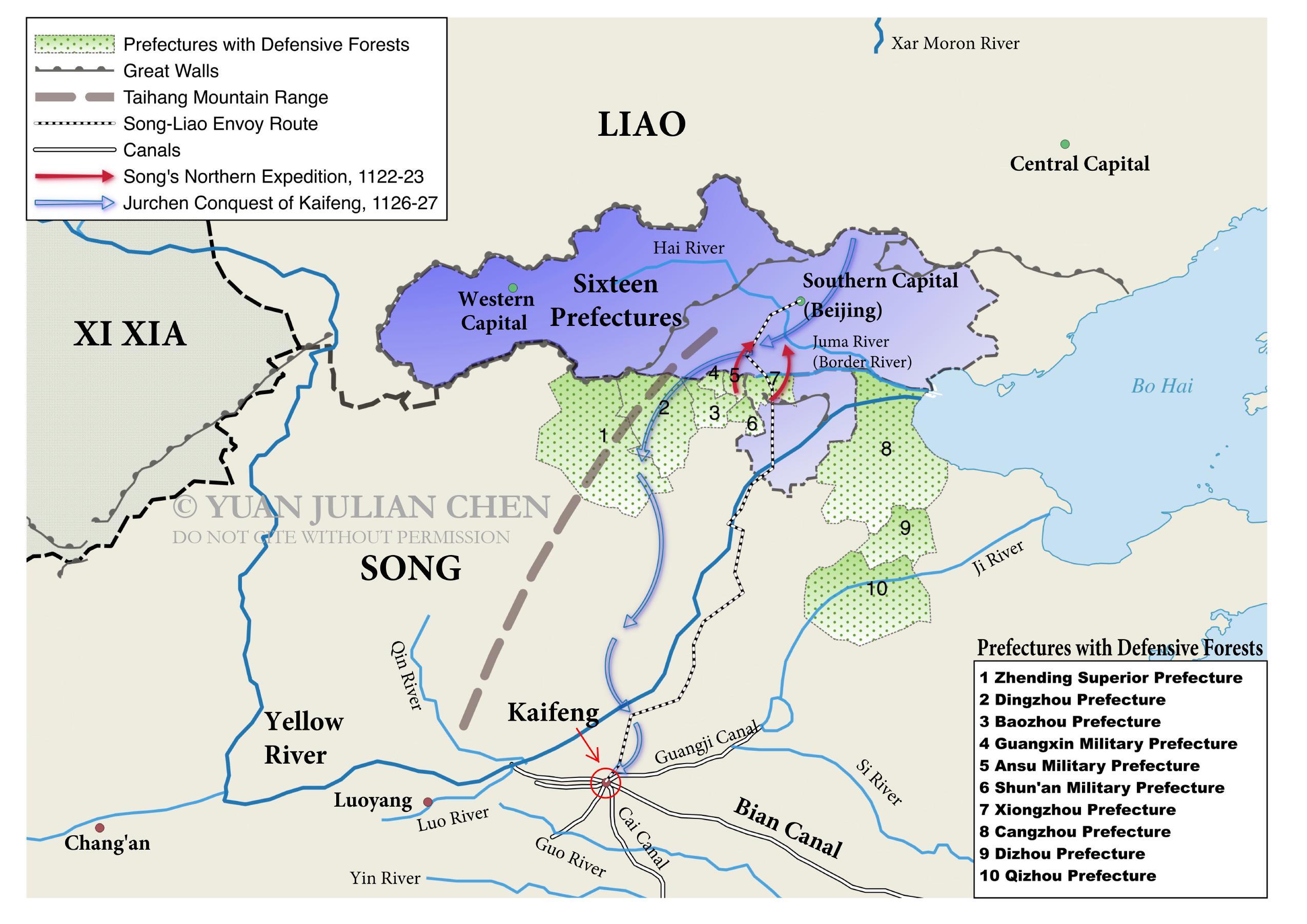
Song defensive forest in the north along its border with the Khitan Liao (Image Source: Chen, "Frontier, Fortification, and Forestation") Reproduced here with permission from author. Please do not cite without permission.
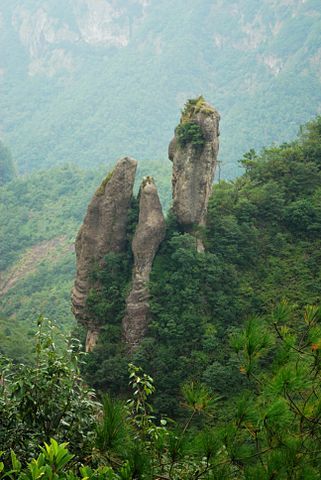
Rock formation in Yandang Mountain, as seen today (Image Source).
For a map of Northern Song Kaifeng, please see here (map in Chinese).
Select Bibliography:
Chen, Julian Yuan. "China’s Song-dynasty Capital of Kaifeng and its Hinterlands: An Environmental History, 960-1127). PhD. diss. Yale University, 2020.
_____. "Frontier, Fortification, and Forestation: Defensive Woodland on the Song–Liao Border in the Long Eleventh Century." Journal of Chinese History Vol. 2, Special Issue 2 (2018): 313-334.
Kubota Kazuo. Sōdai Kaifū no Kenkyū [Research on Kaifeng in the Song Dynasty]. Tōkyō: Kyūko shoin, 2007.
Levine, Ari Daniel. “Walls and Gates, Windows and Mirrors: Urban Defences, Cultural Memory, and Security Theatre in Song Kaifeng.” East Asian Science, Technology, and Medicine 39 (2014): 55–118.
Liu Chunying. Bei Song Dongjing cheng yanjiu [The Eastern Capital of Northern Song]. Beijing: Kexue chubanshe, 2004.
Schaab-Hanke, Dorothee. Kaifeng Around 1120: Kaifeng Around 1120 The Dongjing Meng Hua Lu by Meng Yuanlao: An Annotated Translation. Großheirath: Ostasien Verlag, 2011.
Tsui, Lik Hang. “Complaining About Lived Spaces: Responses to the Urban Living Environment of Northern Song Kaifeng.” Journal of Chinese History 2.2 (2018): 335-353.
West, Stephen H. “Spectacle, Ritual, and Social Relations: The Son of Heaven, Citizens, and Created Space in Imperial Gardens in the Northern Song.” In Baroque Garden Cultures: Emulation, Sublimation, Subversion, edited by Michel Conan, 291–321. Washington, DC: Dumbarton Oaks, 2005.
Zhou Baozhu. Song dai Dongjing yanjiu [The Eastern Capital of the Song dynasty]. Kaifeng: Henan daxue chubanshe, 1992.
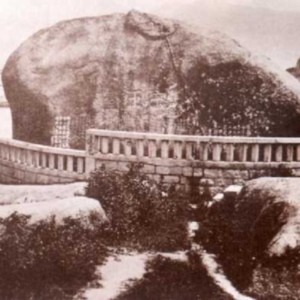
Sunday Dec 26, 2021
The Mongol-Yuan Conquest of the Southern Song
Sunday Dec 26, 2021
Sunday Dec 26, 2021
We hope everyone had a good Christmas! In this episode, Yiming Ha will give an introduction to the forty-four year war between the Mongol-Yuan and the Southern Song. This was one of the longest wars the Mongols had to fight against an adversary and the Southern Song was among the states that put up the longest resistance against the Mongols. This topic is covered very extensively in Chinese language scholarship, but has not received too much detailed attention in English language scholarship. Yiming will talk about the general course of the war, some of the major engagements, the kind of weapons that were used, and some of the implications that this war had on other Mongol conquests and campaigns in Eurasia.
Note: There is a mistake at 12:09 - when Yiming said November, it should actually be December.
Contributors
Yiming Ha

Yiming Ha is a Ph.D. candidate in the Department of History at the University of California, Los Angeles. His current research is on military mobilization and state-building in China between the thirteenth and seventeenth centuries, focusing on how military institutions changed over time, how the state responded to these changes, the disconnect between the center and localities, and the broader implications that the military had on the state. His project highlights in particular the role of the Mongol Yuan in introducing an alternative form of military mobilization that radically transformed the Chinese state. He is also interested in military history, nomadic history, comparative Eurasian state-building, and the history of maritime interactions in early modern East Asia. He received his BA from UCLA and his MPhil from the Hong Kong University of Science and Technology.
Greg Sattler
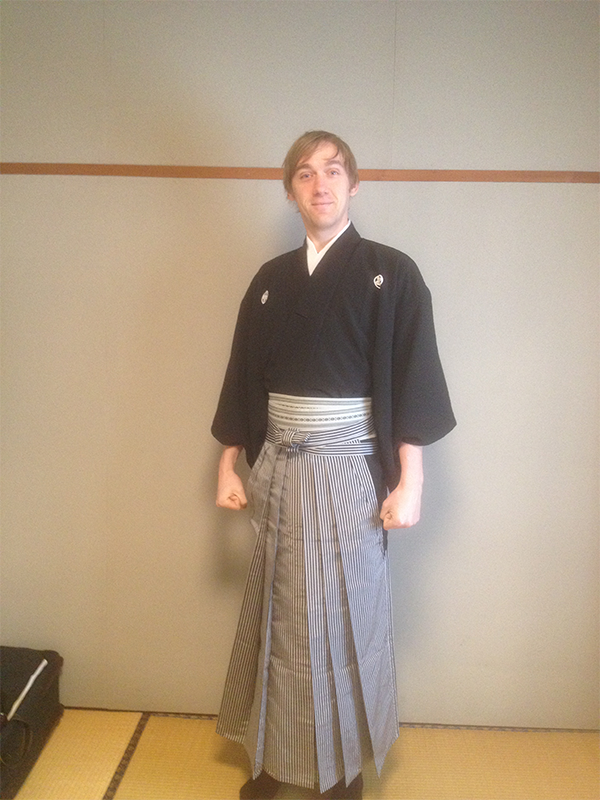
Gregory Sattler is a Ph.D. student in the Department of History at the University of California, Los Angeles. His research focuses on sea merchants in East Asia from the ninth to thirteenth centuries, with a particular consideration of their place in society, their trade networks, and their relationships with government officials. Gregory has recently published an article titled “The Ideological Underpinnings of Private Trade in East Asia, ca. 800–1127” (Journal of Asian Humanities at Kyushu University 6) and he is currently working on two additional manuscripts. He has received degrees in Taiwan and Japan, and is a proficient speaker of both Chinese and Japanese.
Credits
Episode No. 5
Release date: December 26, 2021
Recording location: Los Angeles, CA
Bibliography courtesy of Yiming Ha
Images
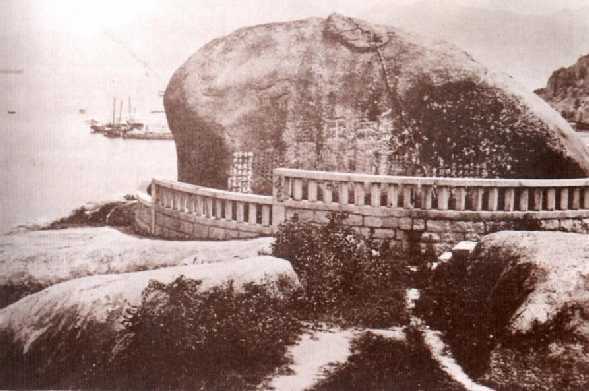
Cover Image: Song Wong Tai 宋王臺, or Terrace of the Song King, was a memorial carved on a large rock in Hong Kong after the Yuan conquest to honor the child Song emperors who died. This picture was taken before it was demolished by Japanese forces occupying Hong Kong for an extension of Kai Tak airport. (Image Source)
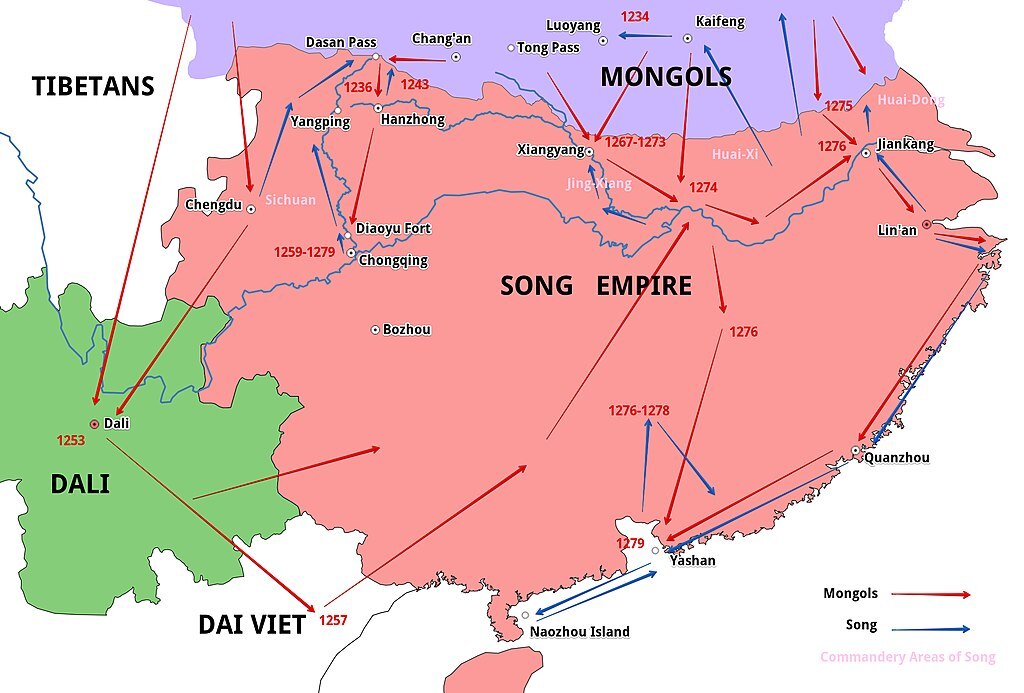
Map of the Mongol invasions of the Southern Song, 1234-1279 (Image Source)
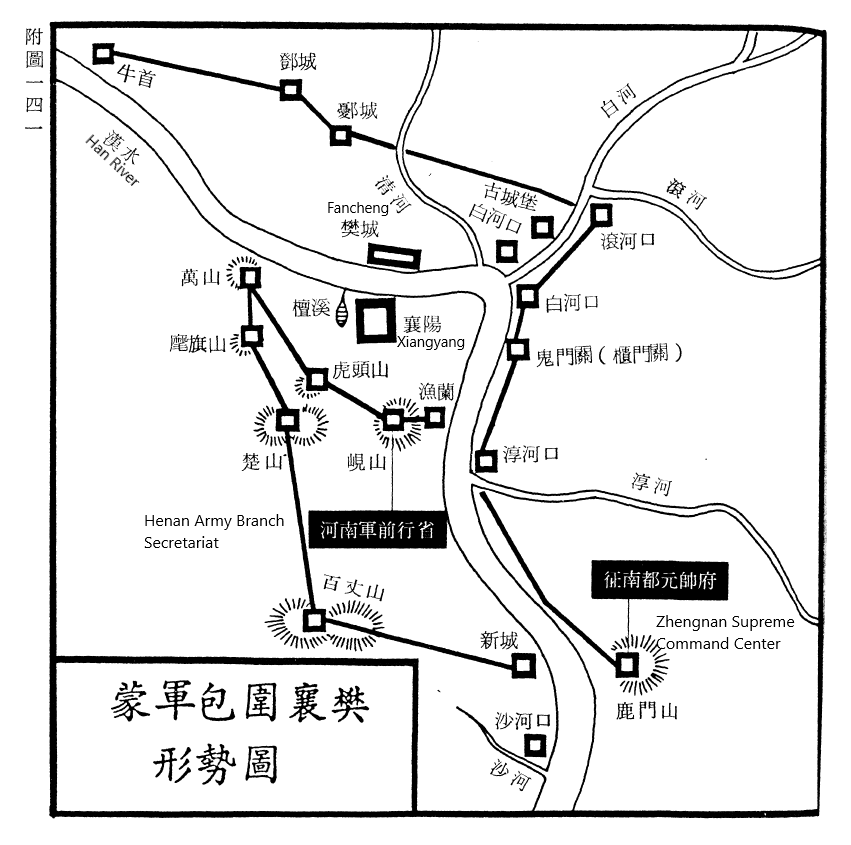
Mongol siege fortifications during the Siege of Xiangyang, 1268-1273 (Image Source: Li, Song Yuan zhan shi)

Song attempts at reinforcing Xiangyang in 1271 (Image Source: Li, Song Yuan zhan shi)
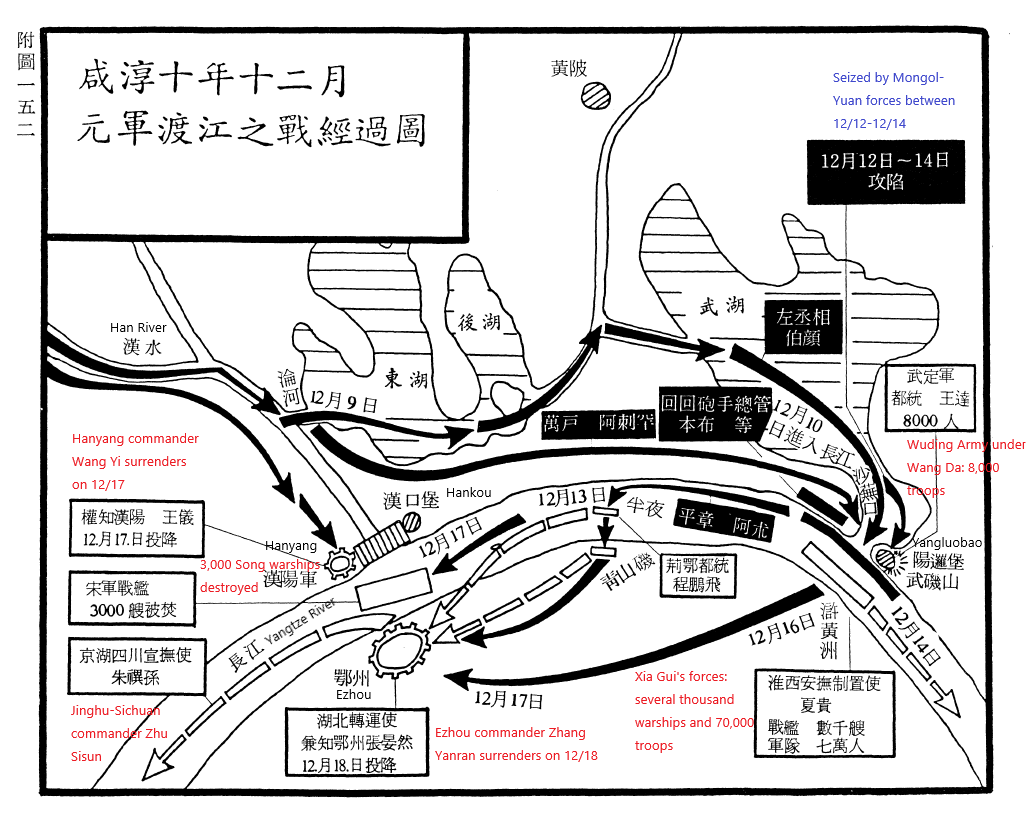
Battle of Ezhou, 1274 (Image Source: Li, Song Yuan zhan shi)
Select Bibliography
Davis, Richard L. “The Reigns of Tu-Tsung (1264-274) and His Successors to 1279.” In The Cambridge History of China, Vol. 5, Part 1: The Sung and Its Precursors, 907-1279, edited by Denis Twitchett and Paul Jakov Smith, 913-962. Cambridge: Cambridge University Press, 2009.
Li Tianming 李天鳴. Song Yuan zhan shi 宋元戰史 [History of the Song-Yuan War]. Taipei: Shihuo chubanshe, 1988.
Li Zhi’an 李治安. Hubilie zhuan 忽必烈傳 [Biography of Khubilai Khan]. Beijing: Renmin chubanshe, 2004.
Lorge, Peter. War, Politics and Society in Early Modern China, 900-1795. London: Routledge, 2005.
Needham, Joseph and Robin D.S. Yates. Science and Civilisation in China: Volume 5, Chemistry and Chemical Technology; Part 6, Military Technology: Missiles and Sieges. Cambridge: Cambridge University Press, 1995.
Sugiyama Masaaki 杉山正明. Kubirai no chōsen: Mongoru ni yoru seikaishi no daitenkai クビライの挑戦 モンゴルによる世界史の大転回 [Khubilai’s Challenge: The Mongols and World Revolution]. Tokyo: Kodansha, 2010.
Wu Guoqing 武國卿. Zhongguo zhanzheng shi, diliu juan: Yuanchao shiqi, Mingchao shiqi 中國戰爭史,第六卷:元朝時期,明朝時期 [History of Warfare in China, Vol. 6: Yuan Dynasty Period and Ming Dynasty Period]. Beijing: Renmin chubanshe, 2016.
Yamauchi Shinji 山内晋次. Nissō bōeki to “iō no michi” 日宋貿易と『硫黄の道』 [The Japan-Song Trade and “The Sulfur Route”]. Tokyo: Yamakawa shuppansha, 2009.
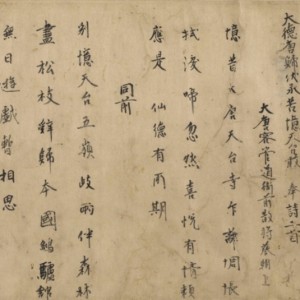
Sunday Oct 31, 2021
Sunday Oct 31, 2021
In our very first episode, Greg talks about some aspects of his research on the growing role of Chinese merchants in the East Asian sea trade between the 10th to 12th centuries. Diplomacy from the 7th to 9th centuries was dominated by official embassies that neighboring states dispatched to the Sui-Tang courts, but after the fall of the Tang dynasty in the early 10th century, private merchants from southeastern China began to dominate the maritime trading routes to Japan, Korean, and Southeast Asia. Greg shares with us some information about why that came to be, where these merchants came from, where they show up in the textual records, and some of the implications that this had for Sino-Japanese relations.
We apologize for some of the audio quality in this episode. We are just starting out and we are working to improve our audio quality!
Contributors:
Greg Sattler

Gregory Sattler is a Ph.D. student in the Department of History at the University of California, Los Angeles. His research focuses on sea merchants in East Asia from the ninth to thirteenth centuries, with a particular consideration of their place in society, their trade networks, and their relationships with government officials. Gregory has recently published an article titled “The Ideological Underpinnings of Private Trade in East Asia, ca. 800–1127” (Journal of Asian Humanities at Kyushu University 6) and he is currently working on two additional manuscripts. He has received degrees in Taiwan and Japan, and is a proficient speaker of both Chinese and Japanese.
Yiming Ha

Yiming Ha is a Ph.D. candidate in the Department of History at the University of California, Los Angeles. His current research is on military mobilization and state-building in China between the thirteenth and seventeenth centuries, focusing on how military institutions changed over time, how the state responded to these changes, the disconnect between the center and localities, and the broader implications that the military had on the state. His project highlights in particular the role of the Mongol Yuan in introducing an alternative form of military mobilization that radically transformed the Chinese state. He is also interested in military history, nomadic history, comparative Eurasian state-building, and the history of maritime interactions in early modern East Asia. He received his BA from UCLA and his MPhil from the Hong Kong University of Science and Technology.
Credits
Episode No. 1
Release date: October 31, 2021
Recording location: Los Angeles, CA
Bibliography courtesy of Greg

Tōjin sōbetsushi narabini sekitoku 唐人送別詩幷尺牘 (Chinese Farewell Poems and Writings). From the Onjō-ji collections 園城寺蔵, currently held in the Nara National Museum 奈良国立博物館.
Select Bibliography

